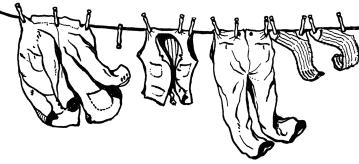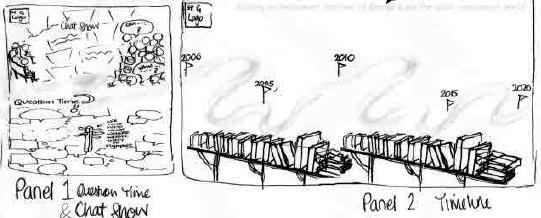User involvement from a bus to Clapham
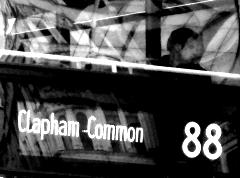
|
History, impressions and reflections by Andrew Roberts |
Critical Perspectives on User Involvement (2011). is a collection of essays developed from a conference I went to in Brighton in 2009. In 2015 I went to another conference, at St George's Medical School, near Clapham, where they sought to build an involvement timeline. I found the conferences and the book difficult because I did not really understand the terms being used.
In this article I want to explore the meaning of user involvement, and related terms in a way that explains to me, and possibly to you, what we are talking about. In particular I will be looking at what the book is talking about and what people were talking about at the recent conference. The book and the conference both tried to create histories of user involvement and I will try to do the same.
According to the Advocacy Project in 2015:
"user involvement is making sure the voices of people are heard and they are able to actively shape and improve the services they use and influence local and national policy."
The word involve comes from "rolling up in": People who are involved are included. They participate (take part). Participation and involvement bring two sides together.
In 1988 an International Conference on User Involvement in Mental Health Services was held in Brighton. It was a new way of speaking. In 1988, many mental patients were already part of a vocal movement and the idea of the conference was that they and others should be involved in services from the top, rather than just receiving them and/or protesting them. According to the full conference title, users and services had "common concerns".
One of the participants was the American activist Judi Chamberlin, author of On Our Own - Patient controlled Alternatives to the Mental Health System (1978). As that title shows, there were different perspectives on involvement in the system.
User movements start when we talked to one another on our own terms
The first essays in
Critical Perspectives on User Involvement are on user
movements, including their history. What we are now calling user movements
existed long before they were involved. And they covered much more than
mental health. User movements were a development in our social ability to
speak about our own lives, in our own terms, to one another. We spoke to
one another first. Involvement followed when users and rulers engaged
with one another.
Before and after the second world war the stigma of disability was
intense. In the early 1940s, for example, a mother who attempted to meet
other parents of handicapped children to form a playgroup had her
advertisement refused by her local paper because of the "shame and
disgrace" of having a handicapped child. In
1946 parents like her formed
The Association of Parents of Backward Children (now Mencap).
Service providers were very sure that they knew better than users. When
children went into hospital parents were kept away to allow the child to
settle in. It worked. Children cried, despaired, grieved, and gave up. It
took science and parent power to convince the hospitals that children and
parents should be kept in contact. One father of a child psychologically
disturbed by separation in
1945 made scientific films of what happened to
children and published newspaper articles. In Battersea Park (on the way to
Clapham) mothers talked about the articles as they pushed prams in
1961.
They formed Mother Care for Children in Hospital which successfully
campaigned for unrestricted visiting
The drug Thalidomide was marketed in Britain from
1958 as a safe
tranquilizer and sleeping pill. By 1961 the Lancet reported deformed
babies
born to mothers who had taken thalidomide. In
1963 the Patients
Association was formed to represent patients, rather than
professionals, in
issues like this.
User research just grows out of talking to one another
Out of talking to one another grew consumer research. This was a change in
the way we look at things. It described what the world feels like when you
are at the receiving end. Eventually, governments took notice of what was
happening and tried to coordinate with users and this is what is called
involvement.
In
1962 the mental health historian Kathleen Jones insisted
that
See Alex Mold

|
"It is not possible to do 'consumer research' in mental hospitals" because patients' "very decided views" "are frequently conditioned by their illness" and "subjective experiences" (Mental Hospitals at Work, page x). |
In the late 1990s Diana Rose and Alison Faulkner turned survivor efforts like Frank's into formal research using "methods" they had learnt in Universities. Methods, they implied, are the poetry governments listen to. Diana's approach was called User Focused Monitoring, whilst Alison's was Strategies for Living. One focused on the evaluation of services, the other on the creative discovery of new ways.
Critical Perspectives on User Involvement received its largest number of submissions from people involved in survivor research
| An experiment in creating a history | To make a story of the past and the future of user involvement in research we could get researchers and others together and ask them to chat about it whilst pegging their memories and visions on a clothes line in date order. |
This conference began with Kati Turner (a survivor) and Steve Gillard (an academic) describing how they were brought together at St George's, ten years before (about 1.6.2005) to collaborate in research, and how their little cubbyhole grew to a roomful of survivors and researchers.
They told how they made contact with others to link patients in nearby Springfield Hospital and other places to work that has been reported since 2000 in the government's INVOLVE Newsletter (first called "Consumers in NHS Research Support Unit News". Survivor research was in the mainstream.
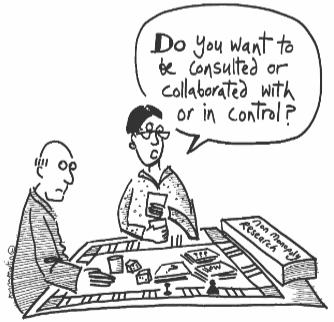
|
To collaborate is to work together
A cartoon in INVOLVE Newsletter in the summer of 2004 asked "would you like to be consulted, to collaborate, or to be in charge?". According to the conference publicity, one of its themes was that working together was much more useful than just being consulted, but that users should be designing, carrying out, writing and publishing our own research. |
I am hard of hearing, so I may have missed the explanation and development of the being in charge theme by Steve and Kati. I heard it discussed from the floor.
Contributions from the floor
Contributions from the floor contrasted the detached observations of
outsiders (who sometimes call themselves scientists) with the lived
experiences of people who suffered distress or disability.
Shelley Harper, who
has been involved with the local
Mental Health Trust since
1995 and has campaigned on disability rights
since the 1970s, said that nothing can replace the contribution that lived
experience can make to research. It is essential, for example, to
understand the loss of identity that so often accompanies distress and
disability. Participating in research can be part of one's recovery of
identity.
Involvement work in relation to mental distress at St George's was preceded
by many years of collaborative work with and by people with learning
disabilities.
Amongst those who invited Steve Gillard to St George's was
Sheila Hollins
who found that by drawing pictures she could help her and her teenage son,
who has a learning disability, discuss and understand what was happening
in their lives. In
1989
she had published the first
"Books Beyond Words",
one about when mum died, the other about when dad died.

|
|
| This Beyond Words cartoon shows how discussing pictures can help us sort out the confusion of words |
Irene Tuffrey-Wijne, who began work with Sheila Hollins in 2001, spoke about the contribution of people with learning difficulties to research. Irene founded a website about breaking bad news to people. Irene was diagnosed as a breast cancer patient in 2014, aged 50. She began blogging about it. We are still finding new social abilities to speak about our own lives, in our own terms, to one another and, as after 1945, talking to one another, and understanding one another, comes first.
|
Roz Austin (Oates), from Durham University, spoke of her
postgraduate work
with other voice-hearers exploring telling one's story, and other creative
writing, as a means of discovery and recovery. She showed us the picture
postcards she used to involve others in her work and left a copy of a book
of creative writing she had helped to produce.
In 2014 Diana Rose was appointed (the world's first) Professor in User-Led Research. She works at the Institute of Psychiatry at King's College London. She made it clear that the dizzy heights that user research has attained have disadvantages as well as advantages. |
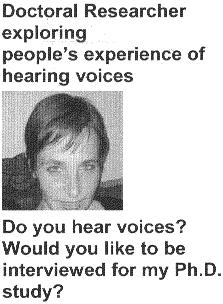
|
Thomas Kabir drew our attention to a report in the British Journal of Psychiatry called "Impact of patient involvement in mental health research: longitudinal study", by Liam Ennis and Til Wykes, two of Diana's colleagues at the Institute of Psychiatry. This is not, unfortunately, in pictures, but I still plan to read it.
Many people spoke about peer support, which just means support from people like us. This is one aspect of talking to one another. We can think of it as involvement with one another, if we wish.
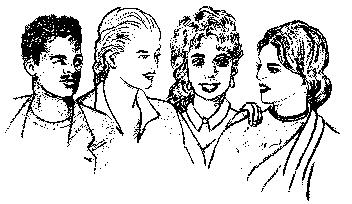 Lena Cournand: "Young People" 1998
Lena Cournand: "Young People" 1998
|
Since 1945 these islands have changed. In 1945 I knew one black person. The war had brought him here from Jamaica. He was a sailor. I was a baby. He carried me on his shoulders. I was lucky. Most people in London only had white friends. |
Today we are a multicultural society and movements that express our diversity start, as always, with people talking to one another. There was not much opportunity for this at the St George's history event. Jayasree Kalathil said that "despite talking about the need to be diverse and inclusive" the "vast array of different experiences, identities, skills and backgrounds" in the UK survivor movement are not found at conferences like this. Academic "survivor research is, by and large, a homogenous place". "This room, today, reflects this fact".
The bird of wisdom
Let us look at just one aspect of the personal experience of some people.
In January
2008
Yvonne Christie wrote a letter headed
"This UK Black
Phenomenon" in which she said there are at least three "groups
of
victimised people whose experience of oppression have left them confused
and overrepresented in prisons and psychiatric institutions, dependent on
drugs and alcohol (possibly denial of self too)" : black people here in the
UK - indigenous Americans (Indians) and the aborigines in Australia.
History and our mental condition (psyche), she said, need to be studied
side by side. There is a dialogue between the dominant culture and the
self-identity of minority groups that can destroy us. On the other hand,
when people speak to one another, they can develop what
Tower Hamlets
African and Caribbean Mental Health Organisation (THACMHO) has
called
health through history.
THACMHO started in
1996 as a place to talk by psychiatric patients of
African descent who found that they got more medication, but less talking
therapy, than other people being processed by the system. Early
conversations focused on the low self-esteem communicated by the idea that
their history was the history of slavery. The group set about researching
what their history actually was.
For Black History Month in
2001 they organised a history walk through Tower
Hamlets, visiting sites associated with five African writers from the end
of the 18th century. After further research, they wrote and published
Power
Writers and the Struggle Against Slavery - Celebrating five African writers
who came to the East End of London in the 18th century
(2005).
Before THACMHO, local historians began the history of black people in Tower
Hamlets in the
1950s. An individual who forgets who he or she is loses
identity. A people robbed of its history is similarly afflicted.
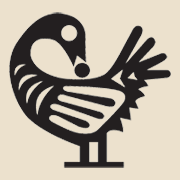
|
THACMHO argues that "We must go back and reclaim our past so we can move
forward; so we understand why and how we came to be who we are today.".
One of its symbols is the Sankofa bird who turns to recover the past in order to fly forward. In the Akan language of Ghana, "sanko" means "go back" and "fa" means take. |
The Sankofa bird flies forward while looking backward with an egg in its mouth. The egg symbolizes the future.
|
Let the tiger roar
Diverse cultures have contributed a richness of symbol and ways of acting to the survivors movement. One of the most creative of these is SIMBA the tiger.
In the Autumn of 1998 mysterious notices all around the Maudsley psychiatric hospital in south London warned that the tiger was coming. |

|
SIMBA (Share In Maudsley Black Action) was set up by three black patients. The Swahili name, Simba, indicates strength and courage. Its first official meeting was in December 1998 and the first issue of The Voice of SIMBA: let the tiger roar , the newsletter of SIMBA "the Black Patient/User/Survivor group in the Maudsley Hospital" was published in October 1999. SIMBA avoided being involved in the sense of being "rolled up in" procedures.
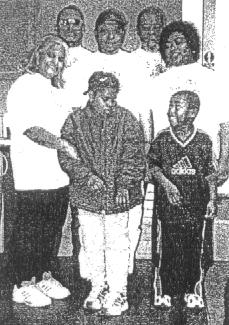
|
"We reckoned that user involvement was about hearing the voices of
users/survivors, and we felt we could be heard much more powerfully and
effectively as real live people through our creative work than through
standard user involvement systems."
Instead they chose to discover themselves and represent themselves in their own way. "Emancipate yourself from mental slavery, None but ourselves can free our minds" Bob Marley The picture shows members of the tiger family preparing to attack. Premila Trivedi (left) - Paulette Thomas and her children (the cubs) Shanice and Aaron - and (back row) Linden Falkener, Gary Elson and Lionel. |
SIMBA refused invitations to sit on committees. Amongst the few invitations it accepted was when they were given half an hour to present their case at the Annual General meeting of South London and Maudsley NHS Foundation Trust in January 2000. Accompanied by African drums they sang the SIMBA Anthem, written collectively, and stated their demands in poems such as Free Again by Linden, Dr SIMBA by Andrew, Medication, Control and Restraint by Bobby, The Side Effect by Gary, Images of Me by CP, I often Sit by Paulette and Is there a Doctor in the House by Mariyam, with Premila doing the interconnecting blurb. It concluded with the SIMBA take on Martin Luther King's I have a dream speech and Bob Marley's Redemption Song
|
Orthodox involvement does not reach bus passengers
Evidence suggests that orthodox involvement does not reach bus passengers like Sheila Patel, Peter Bangay, you and I. It calls us "hard to reach". |
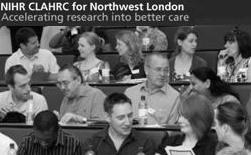
|
CLAHRCs (Collaboration for Leadership in Applied Health Research) began in 2008. They involve health services with universities and also include some users. In 2015, Alicia Renedo and Cicely Marston published an analysis of user members they interviewed from North West London CLAHRC. "Almost all were white, educated, and had professional backgrounds". Thirteen were retired and their typical age was 65 years. Codes of conduct included "wearing a suit".
Debbie Roberts of Engage Visually gave shape to the day with a six metre cartoon of a river winding through words and pictures of our diverse discussions, entering the mainstream of University research and flowing on into a future that relates to people in the street and the community.
Debbie's work seeks to make the closed world of conferences available to ordinary people in the same way that manga (picture comics) made literature available in Japan after the second world war.
Her cartoon story of the day linked all the parts together. Her pre- conference sketch, below, shows how the cartoon was conceived in two parts, discussion and timeline, and how the flowing river united them in one rich story.
The St George's conference organisers asked us to
"bring in any items [you] feel are relevant to put on the timeline. This could be in words, drawings, pictures, poems, an idea, names, projects, a journal paper, a research project or anything at all that you feel belongs on there."
On the table that ran below the clothes line people put publications, which were recorded on the bookshelf on the cartoon.
The Engage Visually cartoon gave us one possible history of user research - The one based on the discussion and clothes line experiment at this conference. Debbie was commissioned, in the words of the conference organisers, to make the collective work on the clothes line "look amazing".
Diana Rose commented afterwards that the timeline as a research method has limitations because researchers have different philosophies, methodologies and political approaches to survivor involvement which are not reflected in the idea of a continuously flowing river. Diana is working on a history project that will explore these differences.
It seems to me that the clothes line approach provides necessary empirical material for more sophisticated ways of writing history. The materials that people collected, together with the cartoon representation ,will be helpful as a resource. Photographs were taken of the results and it is possible, but not certain, that St George's may make these and the publications collected available for historical research.
The snippets that I have been able to preserve and research have been useful, but have not provided any continuity of vision. If the history of St George's is to be related to a wider history, it would be useful if those who have worked there could take the time to systematically outline what they have done. I have attempted to do this from the outside on the Survivors History Timeline. I am hoping that someone at St George's will help me correct any inaccuracies in this and to provide a more balanced account..
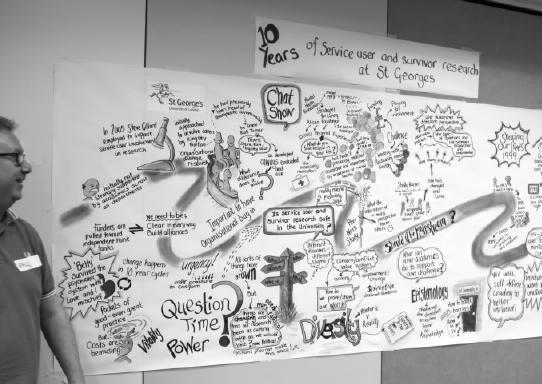 Paul Bergone admires the Engage Visually cartoon he helped to create
Paul Bergone admires the Engage Visually cartoon he helped to create
Lunch was followed by discussion about how safe survivor research is in Universities and finally by our speculations about the future. The river flowed so fast I felt I was going over Niagara Falls. But when the turbulence subsided, a river still flowed.
Reflections on two days
The day at St George's expressed the enthusiasm of many people for what
they have been doing, and brought together ideas and materials, some
of which may be preserved and used in histories that other people can read
and relate to. However, it left me confused as well as enthused.
Making histories of user involvement in survivor research means more than
getting people together and hanging memories on a line. We should work on
actually writing histories. The day in Brighton, also confusing and
enthusing, was followed by some history writing, but the book in which the
history was published still used insiders' language.
There is room for different styles, but I hope
that at least one of the stories we will write in the future will be
relevant to and understood by
Sheila Patel and Peter Bangay having a breakdown and surviving in Clapham,
Glasgow, Dublin or Beddgelert.
Bibliography and biography (links)
Advocacy Project:
http://www.advocacyproject.org.uk/user-involvement/user-
involvement/
Bangay, F. 1999 Naked Songs and Rhythms of Hope "An
illustrated
collection
of poems from 1974 to 1999 by Frank Bangay" [with historical notes],
London: Frank Bangay and Spare Change Books.
Barnes, M. and Cotterell, P. 2011 (Editors) Critical
Perspectives on User
Involvement Bristol: Policy Press.
Beresford, P., Hopton, J., and Linnett, "Peter Beresford on
the need
for
a survivor-controlled museum of madness" and dialogue. Available at
http://studymore.org.uk/mpuhist.htm
Books Beyond Words website:
http://www.booksbeyondwords.co.uk/
Campbell, P., Dillon, J. and Longdon, E. 2013 "Service users and survivors
by Peter Campbell, Jacqui Dillon and Eleanor Longden", Chapter seven in
Cromby, J., Harper, D. and Reavey, P. 2013 Psychology, Mental Health and
Distress
Chamberlin, J.
1978 On Our Own: Patient-Controlled Alternatives to the
mental health system New York: Hawthorn Books 1978 - McGraw-Hill
paperback
1979 - London: MIND 1988.
Chamberlin, J.
1990 "The Ex-Patients' Movement: Where We've Been and Where
We're Going" by Judi Chamberlin - National Empowerment Center USA The
Journal of Mind and Behavior Volume 11, Number 3, Summer 1990.
Annotated
copy available at
http://studymore.org.uk/xjud.htm
Christie, Y. 2008 "This UK Black Phenomenon" by Yvonne Christie. January
2008. Available at
https://web.archive.org/web/20150702124054/http://www.survivor-
research.com/index.php/publications/25-this-uk-black-phenomenon
Cohen, G. 1964 What's Wrong with Hospitals? A Penguin special
Cromby, J., Harper, D. and Reavey, P. 2013 Psychology, Mental Health and
Distress Basingstoke and New York: Palgrave Macmillan
Engage Visually website:
http://www.engagevisually.co.uk/
Ennis, L. and Wykes, T, 2013 "Impact of patient involvement in
mental
health research: longitudinal study" British Journal of Psychiatry
(September 2013 or November 2013, 203 (5) pp 381-386) Available:
http://bjp.rcpsych.org/content/bjprcpsych/early/2013/08/23/bjp
.bp.112.119818.full.pdf
Faulkner, A. 1997 Knowing Our Own Minds - Users Views of
Alternative and
Complementary Treatments in Mental Health, London, Mental Health
Foundation
Faulkner, A. and Layzell, S. 2000 Strategies for Living: A
Report of User-
led Research into People's Strategies for Living with Mental Distress,
Mental Health Foundation
Faulkner, A. and Kalathil, J. 9.2012 The Freedom to be, the
Chance to
Dream: Preserving User-led Peer Support in Mental Health Together.
September 2012. Available at http://www.together-uk.org/wp-
content/uploads/2012/09/The-Freedom-to-be- The-Chance-to-dream-Full-
Report1.pdf
Gillard, S., Turner, K. and Neffgen, M. 2013 "How does who we are shape the
knowledge we produce? Doing collaborative research about personality
disorders" Chapter five in Staddon, P. 2013 Mental Health Service Users
in
Research: Critical Sociological Perspectives
Harper, S. 2015 "Service user perspectives on neuropsychiatry" by
Shelley
Harper Neuropsychiatry News January 2015 available at
http://www.rcpsych.ac.uk/pdf/Neuropsychiatry%20Faculty%20Newsletter%20Janua
ry%202015.pdf
INVOLVE website:
http://www.invo.org.uk/
Jones, K. and Sidebotham, R. 1962 Mental Hospitals at
Work International
library of sociology and social reconstruction. London: Routledge and Kegan
Paul
Kalathil, J. 24.3.2009 Dancing to Our Own Tunes: Reassessing Black and
Minority Ethnic Mental Health Service User Involvement National Survivor
User Network.
Original available as part of 2011 review at
http://www.nsun.org.uk/assets/downloadableFiles/dtoots_report_reprint-oct-
20112.pdf
Kalathil, J. and others 2011 Recovery and Resilience: African, African-
Caribbean and South Asian Women's Narratives about Recovering from Mental
Distress by Jayasree Kalathil and others.
Mental Health Foundation and Survivor Research. Available at
http://www.mhpf.org.uk/resources/research/recovery-and- resilience-african-
african-caribbean-and-south-asian-women%E2%80%99s- narrati
LeFrançois, B.A., Menzies, R. and Reaume, G. 2013 (Editors) Mad
Matters: A
Critical Reader in Canadian Mad Studies Canadian Scholars' Press Inc.
Toronto
Mold, A. 10.2010 "Patient Groups and the Construction of the Patient-
Consumer in Britain: An Historical Overview". Journal of Social
Policy,
October 2010 39(4), 505-521. Available at
http://www.ncbi.nlm.nih.gov/pmc/articles/PMC2925204/
Mold, A. 2013 "Repositioning the Patient:?: Patient Organizations,
Consumerism, and Autonomy in Britain during the 1960s and 1970s"
Bulletin
of the History of Medicine Summer 2014 pp 225-249. Available at
http://www.ncbi.nlm.nih.gov/pmc/articles/PMC3752975/
Oor Mad History - A Community History of the Lothian Mental Health
Service
User Movement. CAPS (The Consultation and Advocacy Promotion Service)
Edinburgh available
at
http://studymore.org.uk/oormadbo.pdf
Plumb, A. 2013 Ken Lumb and Anne Plumb's grassroots archives
available at
http://studymore.org.uk/grasarch.htm
Renedo, A. and Marston, C. 6.2015 "Spaces for Citizen
Involvement in
Healthcare: An Ethnographic Study" Sociology June 2015 49: pages 488-504.
Available at
http://soc.sagepub.com/content/49/3/488.full.pdf+html
Roberts, A. 1985 (Lead author) Mental Distress in Old Age: Time for
Action. City and Hackney Community Health Council,
Rose, D. 1998 In our experience: User-focused monitoring of
mental health
services in Kensington and Chelsea and Westminster Health Authority
Sainsbury Centre for Mental Health.
Russo, J. and Rose, D. 2013 '"But what if nobody's going to sit down and
have a real conversation with you?" Service user/survivor perspectives on
human rights' Journal of Public Mental Health, 12 (4)
Survivors History Group 2011 "Survivors History Group takes a critical look
at historians". Chapter one (pages 7-18) in the Policy Press (Bristol)
publication Critical Perspectives on User Involvement edited by Marian
Barnes and Phil Cotterell.
Survivors History Group 12.2011 "Emotional Journeys"
by by Philip Morgan, Sadie Gower and Andrew Roberts from Time
Together
December 2011. An adaptation aAvailable at
http://studymore.org.uk/SHGEmote.doc
Survivors History Timeline - Mental health and survivors movements
http://studymore.org.uk/mpu.htm, archived, under Mental health history
timeline, in the UK Web Archive at www.webarchive.org.uk/ukwa/target/145406
Staddon, P. 2013 (Editor) Mental Health Service Users in Research: Critical
Sociological Perspectives Policy Press
Sweeney, A. Beresford, P. Faulkner, A. Nettle, M. and Rose, D 2009
(Editors) This is Survivor Research. Herefordshire: PCCS Books
THACMHO 2005 Power Writers and the Struggle Against Slavery -
Celebrating
five African writers who came to the East End of London in the 18th century
- Phillis Wheatley, Ukawsaw Gronniosaw, John Marrant, Olaudah Equiano,
Quobna Ottobah Cuguoano. Tower Hamlets African and Caribbean Mental
Health
Organisation
Trivedi, P. March 2001 "Simba roars - A personal perspective
from Premila
Trivedi". Strategies for Living Newsletter March 2001, Issue 12,
pages 2-3.
Available from
http://studymore.org.uk/PTSfl12.doc
Trivedi, P.
and Wykes, Til 2002 "From passive subjects to equal partners -
Qualitative review of user involvement in research" British Journal of
Psychiatry 2002 181 pages 468 to 472. Available at
http://bjp.rcpsych.org/content/bjprcpsych/181/6/468.full.pdf
Trivedi, P. and others August 2002 "Let the Tiger Roar."
Mental Health
Today, August 2002 pages 30-33. Available at
http://studymore.org.uk/PTSMHT02.doc
Turner, K. and Gillard, S. 2011 "Still out there?" Is the service user
voice becoming lost as user involvement moves into the mental health
research mainstream? Chapter fifteen (pages 189-200) in Critical
Perspectives on User Involvement edited by Marian Barnes and Phil
Cotterell.
Wallcraft, J. and Bryant, M. 2003 The Mental Health Service User Movement
in England Policy Paper 2. London. The Sainsbury Centre for Mental Health.
Available at http://studymore.org.uk/policy_2.pdf
Wallcraft, J.; Read, J. and Sweeney, A. 2003 On our own terms - Users and
survivors of mental health services working together for support and
change, London. The Sainsbury Centre for Mental Health. Available at
http://studymore.org.uk/on_our.pdf
Wallcraft, J. Schrank, B and Amering, M. 2009 (Editors) Handbook of Service
User Involvement in Mental Health Research. World Psychiatric Association.
Wiley.
Andrew Roberts likes to hear from users:
To contact him, please
use the Communication
Form
Thank you to Helen Spandler, Sadie Gower, Debbie Roberts, Diana Rose, Peter Beresford, Alison Faulkner, Louise Pembroke, Jayasree Kalathil, Peter Campbell, Mary Nettle and others for their help and criticism respecting drafts of this webpage and Brighton and St George's for inviting me to their events in the first place.
Special thanks to the tigers of SIMBA and the birds of THACMHO for the inspiration to understand why history matters.
User movements start when we talked to one another on our own terms
User research just grows out of talking to one another
An experiment in creating a history
Orthodox involvement does not reach bus passengers
Bibliography and biography (links)
